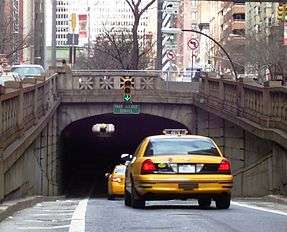Park Avenue Tunnel (roadway)
Coordinates: 40°44′56.3″N 73°58′47.8″W / 40.748972°N 73.979944°W
|
South end of tunnel | |
| Overview | |
|---|---|
| Location | Manhattan, New York |
| Coordinates | 40°44′56.3″N 73°58′47.8″W / 40.748972°N 73.979944°W |
| Route | Northbound Park Avenue |
| Start |
East 33rd Street (entrance ramp) East 34th Street (entrance portal) |
| End |
East 40th Street (exit ramp) East 39th Street (exit portal) (all traffic must continue to East 46th Street) |
| Operation | |
| Opened | 1834 |
| Owner | New York City |
| Operator | New York City Department of Transportation |
| Traffic | Cars (formerly trains and street cars) |
| Technical | |
| Length | 5 blocks, approximately 0.25 miles (0.40 km) |
| No. of lanes | 1 |
| Operating speed | 35 mph (56.33 km/h) |
| Tunnel clearance | 8 feet 11 inches (2.72 m) |
| Width | 16 feet (4.88 m) |
The Park Avenue Tunnel, also called the Murray Hill Tunnel, is a 1,600-foot-long (488 m) tunnel that passes under seven blocks of Park Avenue in Murray Hill, in the New York City borough of Manhattan. Traffic currently goes northbound from 33rd Street toward the Park Avenue Viaduct. The tunnel is under the jurisdiction of the New York City Department of Transportation, and carries one lane of northbound car traffic from East 33rd Street to East 40th Street; from 40th Street north, traffic must follow the Park Avenue Viaduct around Grand Central Terminal to 46th Street. The vertical clearance is 8 ft 11 in (2.72 m).
The IRT Lexington Avenue Line of the New York City Subway runs parallel to the Park Avenue Tunnel in two tunnels below it.[1]
History
The tunnel once carried the New York and Harlem Railroad and later that company's streetcar line, and was then called the Murray Hill Tunnel. The tunnel was originally built as an open rock cut, completed in 1837,[2] after which the NY&H Railroad was opened as far as Yorkville, to 85th Street. In 1850 the cut was roofed over,[2] using granite stringers from the original railroad bed south of 14th Street, thus creating the present tunnel.[3]
Due to the construction of Grand Central Terminal and the removal of tracks, the north end was reconstructed for a steeper approach. Prior to August 3, 2008, the tunnel carried two-way traffic, two lanes, but was reconfigured to increase safety for pedestrians crossing Park Avenue at 33rd Street.[4]
Art installations
In 2013, the tunnel was open to pedestrians for the first time in coordination with the annual Summer Streets event, which shuts down part of Park Avenue to vehicular traffic between 7:00 am and 1:00 pm for three Sundays every August. During the August 2013 event, the interior served as an art space containing Rafael Lozano-Hemmer's Voice Tunnel installation, in which visitors could record a short message that would be played back continuously from speakers along the tunnel walls.[5] In the 2014 Summer Streets, the tunnel temporarily reopened to pedestrians, this time featuring DIVE, an installation by Jana Winderen that incorporates aquatic soundscapes.[6] Both art projects were commissioned by the New York City Department of Transportation.
In popular culture
Parts of the 1998 movie Godzilla were filmed in the tunnel. Toward the end of the film, Godzilla chases the film's main characters into the tunnel, but is later lured back into the open toward the neighboring Brooklyn Bridge.[7] The bridge, however, is in reality over 4.5 kilometres (2.8 mi) from the tunnel.[8]
Gallery
 Interior with Voice Tunnel art installation (2013)
Interior with Voice Tunnel art installation (2013) North end, before the tunnel was converted to one-way northbound
North end, before the tunnel was converted to one-way northbound
See also
References
Notes
- ↑ "Some Features Of The New York Rapid Transit Tunnel" (reprint). Scientific American: 327. May 25, 1901.
- 1 2 Eldredge, Niles & Horenstein, Sidney (2014). Concrete Jungle: New York City and Our Last Best Hope for a Sustainable Future. Berkeley, California: University of California Press. pp. 120–121. ISBN 978-0-520-27015-2.
- ↑ Gray, Christopher (July 21, 2011). "Putting the Park in Park Avenue". The New York Times. Retrieved 2011-09-03.
- ↑ "DOT Announces Safety Upgrade at Park Avenue and 33rd Street/Trial Closure of Park Avenue Tunnel's Southbound Lane" (Press release). New York City Department of Transportation. August 1, 2008. Retrieved 2010-02-19.
- ↑ "Voice Tunnel Preview: Summer Streets 2013". New York City Department of Transportation video. Retrieved on August 30, 2014.
- ↑ Sarah, Cascone, "Dive Into the Park Avenue Tunnel’s Aquatic Sound Art Installation". Artnet News. Retrieved on August 30, 2014.
- ↑ Godzilla at AllMovie
- ↑ "Google Maps". Google. Retrieved May 17, 2014.
External links
| Wikimedia Commons has media related to Park Avenue Tunnel. |
